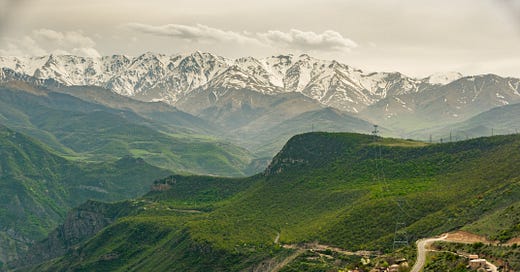In light of recent events in Russia, Ukraine, Israel, and Palestine, President Biden recently stated in a speech that,
...history has taught us that when terrorists don’t pay a price for their terror, when dictators don’t pay a price for their aggression, they cause more chaos and death and more destruction. They keep going, and the cost and the threats to America and to the world keep rising.
President Biden would seem to be contradicting himself since, on September 20th, Azerbaijan committed atrocities against ethnic Armenians in the disputed Nagorno-Karabakh region, and the Biden administration has yet to hold Azerbaijan accountable. This region, while home to a population of 95% ethnic Armenians, is internationally recognized as a part of Azerbaijan. If the United States is to hold a stance against terrorism and in favor of human rights, the Biden administration must hold Azerbaijan accountable for its crimes.
History of the Territory
The Nagorno-Karabakh conflict is the longest-running conflict in post-Soviet Eurasia. In 1923, the Soviet Union established the Nagorno-Karabakh Autonomous Oblast (NKAO) within the Azerbaijan Soviet Socialist Republic. In 1988, ethnic Armenians living in the area requested that the NKAO be transferred from Azerbaijan to Armenia. Following the collapse of the Soviet Union in 1991, these tensions escalated from legal conflict to full-fledged war. In 1993, the fighting ceased, and the region was controlled by Armenian forces. During the war, there were around 30,000 casualties and more than a million displaced people. In 1994, Armenians and Azerbaijanis agreed to a Russia-brokered ceasefire known as the Bishkek Protocol. This agreement left the region de facto independent, but heavily reliant on Armenian resources and ties.
Despite the bilateral agreement to a ceasefire, intermittent deadly incidents —including those that involved drones, shelling, and special operations activities —have continued to occur. April of 2016 marked the most intense fighting in the region since the ceasefire, resulting in hundreds of deaths and foreshadowing what was to come.
On September 27th, 2020, this uneasy balance broke, and the region yet again experienced an all-out war. Clashes were followed by an Azerbaijani offensive, and thousands of soldiers and hundreds of civilians were killed. This occurred over six weeks, until another deal, again brokered by Moscow, ended the bloodshed - for the time being. During this conflict, Azerbaijan reclaimed much of the land that it had lost during the conflict in the 90s, and Armenia retained only a small portion of the Nagorno-Karabakh region.
For Armenians, this caused major issues. The safety of the thousands of ethnic Armenians who remained in the region was put under threat. The end of the fighting caused the situation to be safer for civilians, but there was no provision in the peace deal for the safe evacuation of ethnic Armenians who wished to leave the area.
The Situation Now
Starting in late December of last year, Azerbaijani officials blocked the road in the Lachin corridor, through which food, medicine, and fuel had arrived by truck for Nagorno-Karabakh from the Armenian capital, Yerevan. These materials kept the 120,000 ethnic Armenians in the region alive. From December to April, Red Cross trucks were allowed in, and sick patients were allowed out. Starting in April, Azerbaijan erected a new checkpoint, effectively blocking Armenians in the area from receiving any aid or resources. This starvation siege had clear intent: Baku aimed to starve the Armenian population into submission and, through a slow-motion ethnic cleansing, forced them to leave when the road reopened.
On September 19th, Baku launched a large military attack in Nagorno-Karabakh under the guise of an “anti-terrorist operation.” As a result of this military assault, tens of thousands of ethnic Armenians fled the region for Armenia. Although the Azerbaijani military offensive lasted just 24 hours, it was sufficient for the purposes of Baku. The attack led to local forces in the region agreeing to be disarmed and disbanded, and Nagorno-Karabakh now looks ready to come completely under Azerbaijani control. The region’s separatist leader has stated that the breakaway republic, the Republic of Artsakh, and its institutions will no longer exist as of January 1, 2024.
This forced exodus is pure ethnic cleansing of the ethnic Armenians living in the Nagorno-Karabakh region. As the people of the region were waiting in bread lines, so hungry that they were fainting in line, they were bombarded with bombs. Over 100,000 ethnic Armenians were forced to flee the region, along with their homes, lives, and their ancestral culture of two and a half millennia.
What is Coming Next?
Azerbaijan, despite gaining control of the Nagorno-Karabakh region, is not likely to be satisfied with its conquests. Experts believe that Baku, supported by their key ally Turkey, will next target sovereign Armenia. Azerbaijani President Ilham Aliyev has previously called on Armenia to create a corridor between Azerbaijan and an enclave that borders Turkey, and he has threatened to use force to achieve this. This transportation route, known as the Zangezur Corridor, is likely to be the next target for Azerbaijan, and it seems that they will work to create this route by whatever means necessary. While it seems that Turkey would prefer a peaceful route toward creating this corridor, they have also signaled that should Azerbaijan choose a military route, they would be able to count on Turkey’s support. The presence of Turkey—a regional great power—in the war would likely damn the chances of a successful Armenian defense.
The Role of the US
The United States is aware of the threats towards sovereign Armenia and the clear ethnic cleansing that has occurred in the Nagorno-Karabakh region, yet Washington has made few moves to condemn these activities or hold Azerbaijan accountable. With conflicts like Russia’s invasion of Ukraine and the war between Israel and Hamas, the United States’ focus is elsewhere.
Lawmakers have pushed for the United States to impose targeted sanctions against Azerbaijan on the individuals who were responsible for these violations against human rights. As stated in this letter, “America is a world leader on international human rights and must continue to serve as a mediating force and supporter of peace in the region.” Sanctions like these are necessary for the United States and the Biden administration to maintain their position in support of human rights and against genocide and ethnic cleansing.
While, on paper, Armenia is Russia’s ally, Russia stands to gain from this invasion. Economically, Russia would patrol the corridor, offering them economic leverage. The Kremlin has also been looking to teach Armenia a lesson regarding some of their recent pro-Western flings; a Russian official recently described Armenia as the next Ukraine.
In Closing
Unfortunately, it appears that “Washington is too distracted right now to think about the Caucasus,” as said by journalist Asli Aydintasbas, in light of the Israel-Hamas conflict and the ongoing war in Ukraine. This cannot be the case. As Washington ignores the human rights crimes committed in the Nagorno-Karabakh region, they signal that some democracies, and some lives, are more important than others.





